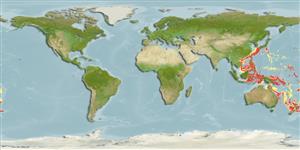Common names from other countries
Environment: milieu / climate zone / depth range / distribution range
Ecologie
; diepteverspreiding 100 - 1463 m (Ref. 409), usually 300 - 600 m (Ref. 409). Tropical, preferred 26°C (Ref. 107945); 33°N - 44°S, 103°E - 176°W
Indo-West Pacific: Madagascar to Japan and New Zealand (Ref. 8). Pérez Farfante recognizes 3 subspecies: Haliporoides sibogae australiensis from Australia; Haliporoides sibogae madagascariensis from Madagascar and Reunion; and Haliporoides sibogae sibogae from Malaysia to Japan and New Zealand (Ref. 75620).
Length at first maturity / Size / Gewicht / Leeftijd
Maturity: Lm ?, range 10 - ? cm Max length : 16.5 cm BL mannelijk/geslacht niet bekend; (Ref. 8); 20 cm BL (female)
Both midwater and demersal species (Ref. 106892). Deep water species (Refs. 82143, 106892). On rocks and rubbles (Ref .99823). Reported to undertake diel vertical migrations; may also bury in the continental slope at night. Feeds almost exclusively on bottom-living prey; actively hunting both night and day (Ref. 106892).
Members of the order Decapoda are mostly gonochoric. Mating behavior: Precopulatory courtship ritual is common (through olfactory and tactile cues); usually indirect sperm transfer.
Holthuis, L.B. 1980. (Ref. 8)
Status op de Rode Lijst van het IUCN (Ref. 130435)
Status bij CITES (Ref. 108899)
Not Evaluated
Not Evaluated
Gebruik door de mens
Visserij: commercieel
FAO - Visserij: landings | FishSource | Sea Around Us
Tools
Internet-bronnen
Estimates based on models
Preferred temperature
(Ref.
115969): 6.8 - 13.8, mean 9.8 (based on 601 cells).
Weerstandsvermogen
Hoog, minimale populatieverdubbelingstijd minder dan 15 maanden (K=0.37-1.74).
Prior r = 0.96, 95% CL = 0.63 - 1.43, Based on 1 data-limited stock assessment.
Kwetsbaarheid
Low vulnerability (10 of 100).
Prijsklasse
Unknown.
